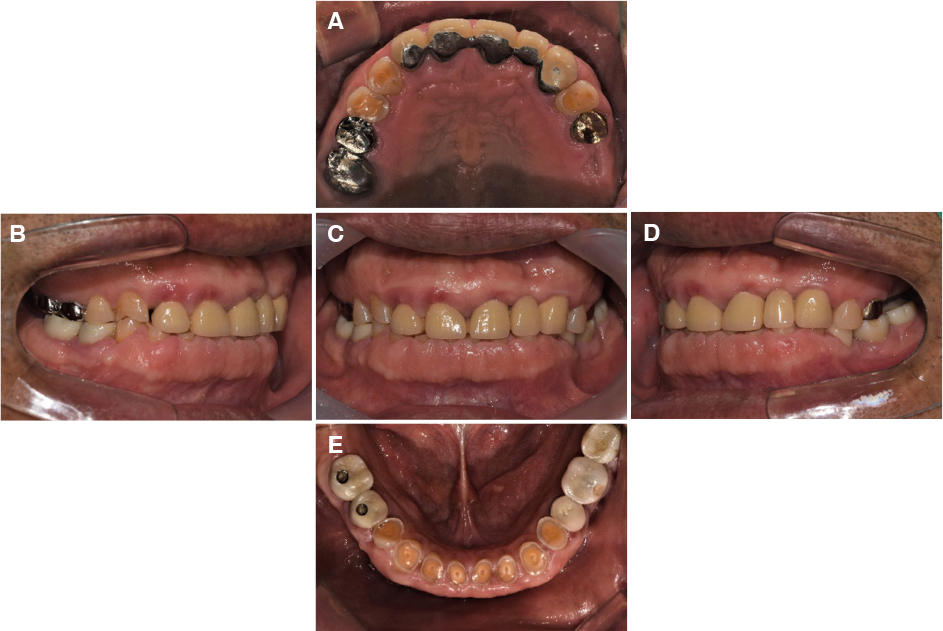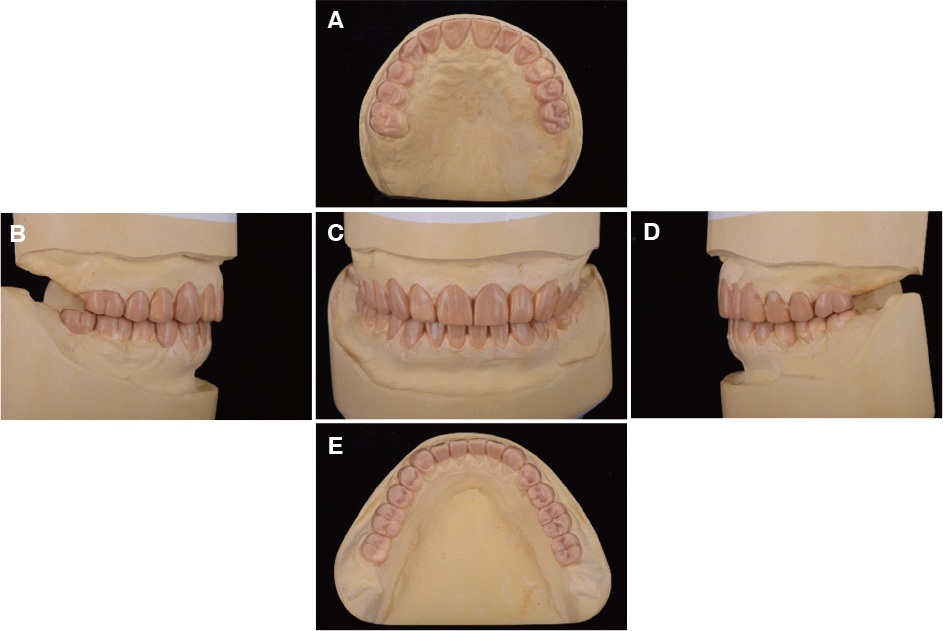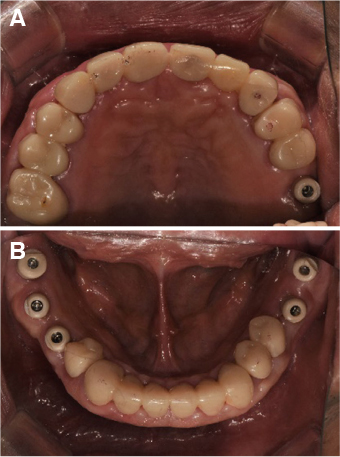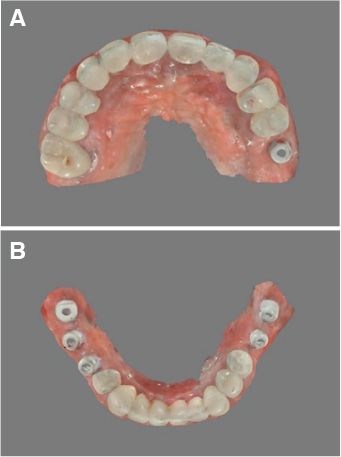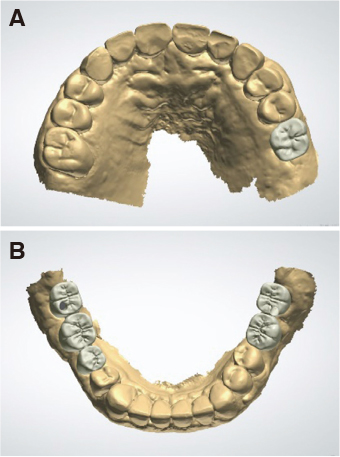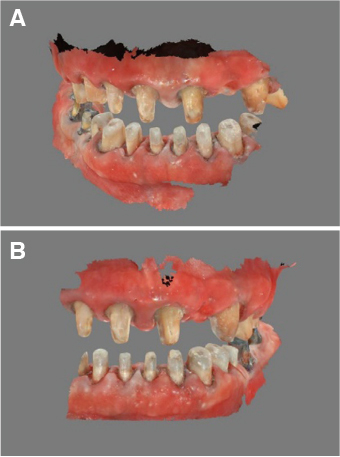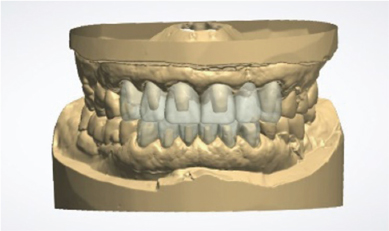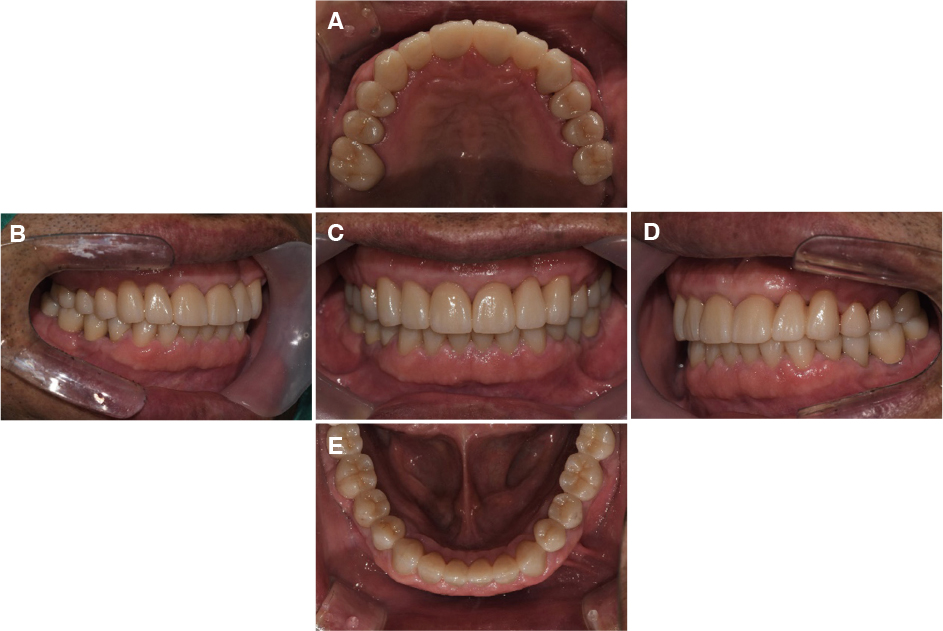J Korean Acad Prosthodont.
2020 Jan;58(1):67-76. 10.4047/jkap.2020.58.1.67.
Full mouth rehabilitation of a severely worn dentition using intraoral scanner and the CAD/CAM double scanning technique
- Affiliations
-
- 1Department of Prosthodontics, School of Dentistry, Seoul National University, Seoul, Republic of Korea. drhiy226@snu.ac.kr
- KMID: 2469923
- DOI: http://doi.org/10.4047/jkap.2020.58.1.67
Abstract
- With the evolution of the computer-aided design/computer-aided manufacturing (CAD/CAM) technology, the intraoral scanners are playing an increasingly important role, as they are the first step towards a completely digital workflow. The CAD/CAM double scanning technique has been used to transfer the information from provisional restorations to definitive restorations. In this case, a 67-year-old male with esthetically compromised anterior teeth, generalized severe attrition of teeth, and reduced vertical dimension was treated with full mouth rehabilitation including a re-establishment of the lost vertical dimension of occlusion assisted by the crown lengthening procedure. The provisional restorations were fabricated using an intraoral scanner and the CAD/CAM double scanning technique. After the period of adaption, the definitive monolithic zirconia restorations were delivered. The CAD/CAM double scanning technique successfully transferred the occlusal and morphological characteristics, obtained from the provisional restorations, to the definitive restorations.
Keyword
MeSH Terms
Figure
Reference
-
1. Turner KA, Missirlian DM. Restoration of the extremely worn dentition. J Prosthet Dent. 1984; 52:467–474.
Article2. Gopi Chander N, Venkat R. An appraisal on increasing the occlusal vertical dimension in full occlusal rehabilitation and its outcome. J Indian Prosthodont Soc. 2011; 11:77–81.
Article3. Song MY, Park JM, Park EJ. Full mouth rehabilitation of the patient with severely worn dentition: a case report. J Adv Prosthodont. 2010; 2:106–110.
Article4. Miyazaki T, Hotta Y, Kunii J, Kuriyama S, Tamaki Y. A review of dental CAD/CAM: current status and future perspectives from 20 years of experience. Dent Mater J. 2009; 28:44–56.
Article5. Nedelcu R, Olsson P, Nyström I, Rydén J, Thor A. Accuracy and precision of 3 intraoral scanners and accuracy of conventional impressions: A novel in vivo analysis method. J Dent. 2018; 69:110–118.
Article6. Amin S, Weber HP, Finkelman M, El Rafie K, Kudara Y, Papaspyridakos P. Digital vs. conventional full-arch implant impressions: a comparative study. Clin Oral Implants Res. 2017; 28:1360–1367.
Article7. Ender A, Attin T, Mehl A. In vivo precision of conventional and digital methods of obtaining complete-arch dental impressions. J Prosthet Dent. 2016; 115:313–320.
Article8. Ueda K, Güth JF, Erdelt K, Stimmelmayr M, Kappert H, Beuer F. Light transmittance by a multi-coloured zirconia material. Dent Mater J. 2015; 34:310–314.
Article9. Baldissara P, Wandscher VF, Marchionatti AME, Parisi C, Monaco C, Ciocca L. Translucency of IPS e.max and cubic zirconia monolithic crowns. J Prosthet Dent. 2018; 120:269–275.
Article10. Joo HS, Park SW, Yun KD, Lim HP. Complete-mouth rehabilitation using a 3D printing technique and the CAD/CAM double scanning method: A clinical report. J Prosthet Dent. 2016; 116:3–7.
Article11. Kim JY, Park SW, Lim HP, Yun KD, Yang H. Rehabilitation in a patient with limited restorable space using double scanning technique: A case report. J Korean Acad Prosthodont. 2017; 55:205–211.
Article12. Song JW, Leesungbok R, Park SJ, Chang SH, Ahn SJ, Lee SW. Analysis of crown size and morphology, and gingival shape in the maxillary anterior dentition in Korean young adults. J Adv Prosthodont. 2017; 9:315–320.
Article13. Patzelt SB, Emmanouilidi A, Stampf S, Strub JR, Att W. Accuracy of full-arch scans using intraoral scanners. Clin Oral Investig. 2014; 18:1687–1694.
Article14. Su TS, Sun J. Comparison of repeatability between intraoral digital scanner and extraoral digital scanner: An in-vitro study. J Prosthodont Res. 2015; 59:236–242.
Article
- Full Text Links
- Actions
-
Cited
- CITED
-
- Close
- Share
- Similar articles
-
- Full mouth rehabilitation in a patient with reduced vertical dimension due to numerous tooth loss and excessie worn dentition: A case report
- Computer-aided design and manufacturing-based full mouth rehabilitation for a patient with excessive attrition and restricted vertical dimension: A case report
- Full mouth rehabilitation using zirconia crown in severe worn dentition: a case report
- Application of various digital technique on full mouth rehabilitation: A case report
- Integrating 3D facial scanning in a digital workflow to CAD/CAM design and fabricate complete dentures for immediate total mouth rehabilitation

